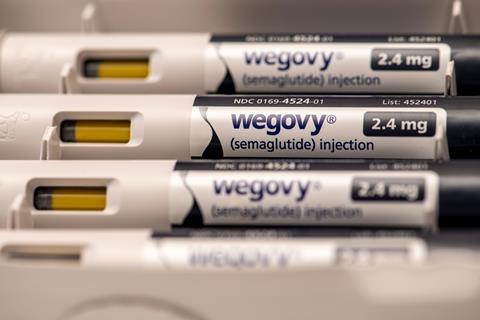Regulatory and pricing reforms have topped industry agendas in 2023, while weight loss drugs surged and Covid-19 therapies waned
Legislation caused consternation for the pharmaceutical industry in both the EU and the US in 2023. First, the EU’s delayed draft pharmaceutical legislation was finally published in late April. Notable proposals include a reduction in the number of scientific committees at the European Medicines Agency (EMA). The EMA would have to be notified more quickly about any impending product withdrawals or shortages, and companies will also have to hold higher inventories of essential medicines. Other provisions include incentives for endeavours such as developing new antibodies.

While welcoming a modernisation of the regulatory system, industry is calling for changes to other proposals. The European Federation of Pharmaceutical Industries and Associations (EFPIA) is concerned there will be a significant reduction in intellectual property rights, with complex incentives for additional protection that would prove impossible to achieve. It believes the ongoing decline in European R&D efforts and clinical trials would be accelerated.
Over in the US, President Biden’s wide-ranging Inflation Reduction Act (IRA) is already starting to bite the pharma sector. Its provisions include several designed to cut healthcare costs, notably by requiring Medicare (the federal healthcare programme for the elderly) to negotiate medicines prices directly with pharma companies. This will predominantly affect expensive drugs that have already been available for a few years (seven for a small molecule, 11 for a biologic), and do not have generic or biosimilar alternatives.
Industry’s fear is that, while this only directly affects Medicare pricing for some drugs, it could have a wider effect on the prices insurance companies are willing to pay in future. Some disease areas are likely to be more affected than others, particularly those that disproportionately affect older populations, which may affect pharma companies’ future R&D choices.
Unsurprisingly, the drug companies have pushed back, with numerous lawsuits launched by both companies themselves and the Pharmaceutical Research and Manufacturers of America trade association. While several companies subsequently agreed, albeit begrudgingly, to take part in the negotiations, disquiet continues. The first 10 drugs to make the cut for negotiations were announced in September, with three on the list from Johnson & Johnson, and one each for Bristol Myers Squibb, Merck & Co, Novartis, Lilly, AstraZeneca, Novo Nordisk and Amgen. These 10 together represented more than $45 billion (£36 billion) in Medicare spending in the year to May 2023, and include medicines for diabetes and arthritis. Negotiations will take place up to August 2024, with revised prices due to kick in in 2026.
Buying and selling
After a relatively quiet few years on the big acquisition front, the largest merger deal since 2019 took place in February, when Pfizer spent $43 billion on Seagen and its antibody–drug conjugate (ADC) technology. Also spending heavily on ADCs was AbbVie, with its late-November $10 billion acquisition of ImmunoGen, whose portfolio includes ovarian cancer drug Elahere (mirvetuximab soravtansine). Just a week later, AbbVie spent nearly $8.7 billion on Cerevel Therapeutics and its neuroscience pipeline.
After failing to buy Seagen in 2022, Merck & Co did manage a multi-billion dollar acquisition in 2023, spending $11 billion on Prometheus Biosciences, after something of a bidding war. The San Diego-based biotech’s R&D portfolio includes treatments for ulcerative colitis and Crohn’s disease. Elsewhere in the colitis world, Roche spent $7.1 billion on Telavant, a subsidiary of Roivant that was set up less than a year earlier when it acquired a potential colitis drug for just $45 million from Pfizer (which retained a 25% stake in the new company).
Obesity and diabetes treatments became a vigorous area for acquisitions, fuelled by the huge marketing success of diabetes drugs semaglutide (Wegovy/Ozempic, Novo Nordisk) and tirzepatide (Mounjaro, Eli Lilly) as ways to lose weight. Lilly expanded its investigational portfolio by spending almost $2 billion on Versanis, whose lead drug bimagrumab acts on fat cells. This was just a few days after it paid over $2.4 billion for immunology specialist Dice Therapeutics.

AstraZeneca is also looking at obesity as a potential driver of future revenues, with the $1.8 billion licensing deal for Eccogene’s investigational GLP-1 receptor agonist for cardiometabolic diseases. And towards the end of the year, Roche followed, acquiring Carmot Therapeutics and its three clinical-stage GLP-1 agonists for nearly $2.7 billion.
Among the many other acquisitions during the year, several more topped the billion dollar mark. For example, Novartis spent $3.5 billion on Chinook, which has two investigational kidney disease drugs, and Biogen spent $7.3 billion on Reata Pharmaceuticals and its Friedreich’s ataxia drug Skyclarys. Mirati Therapeutics – with its cancer drug adagrasib (Krazati) – was bought by Bristol Myers Squibb for $5.8 billion.
Astellas spent $5.9 billion on ophthalmology biotech Iveric Bio, while Sanofi acquired Provention Bio for $2.9 billion, for access to diabetes drug teplizumab (Tzield), as well as an immunology pipeline. GSK, meanwhile, spent $2 billion on Bellus Health and its chronic cough treatment camlipixant, which is in Phase 3 clinical trials, while AstraZeneca forked out $1.8 billion for CinCor Pharma and its investigational drug for hypertension and chronic kidney disease, baxdrostat.
Meanwhile, Novartis spun out its generics business Sandoz as an independent company. In doing so, it continues the ongoing trend for pharma companies to focus more tightly on innovative medicines rather than also running portfolios of generics and wider healthcare products.
Openings and closings
Numerous companies are extending their manufacturing footprints, with numerous new sites and capacity expansions, and obesity in particular driving some hefty spending. Lilly is investing almost $1 billion in a biologics manufacturing facility in Limerick, Ireland, and a further $2.5 million on a plant to make injectable products and devices in Alzey, Germany, including diabetes and obesity products. Another $1.6 billion is being spent on expanding capacity for diabetes treatments tirzepatide (Mounjaro) and dulaglutide (Trulicity) in Indiana, US. Both these drugs also have uses in weight loss, although only Mounjaro has formal approval for this.
The burgeoning obesity market is also driving investment at Novo Nordisk, which is spending $6 billion on expanding its Kalundborg, Denmark facility, which makes APIs including semaglutide, the active ingredient in its diabetes and weight loss drugs Ozempic and Wegovy. Novo is spending another $2.3 billion expanding capacity for the drug in Chartres, France, too.
After the success of its Covid-19 vaccine, Moderna continues to invest in both R&D and manufacturing capacity. In the UK, it’s constructing an Innovation and Technology Centre at Harwell, near Oxford, for mRNA vaccines targeting respiratory viruses as part of its decade-long collaboration with the UK government. Completion is slated for 2025. It has also invested more than $300 million in a manufacturing plant in Massachusetts, US.
However, more cuts are being made by Pfizer. As part of a plan designed to save $3.5 billion, a further 500 jobs will be lost at its site in Sandwich, UK, while in the US, two sites in North Carolina and a third in New Jersey will be closed completely.

Genentech’s manufacturing operations at its headquarters in South San Francisco are also being shuttered. This facility was the world’s first to manufacture recombinant proteins on a large scale. Many of the 250-plus staff are shifting over to the clinical supply facility on the same site, while another commercial manufacturing facility is set to be completed next year in Oceanside, southern California.
Numerous other jobs were cut, too, many at biotechs after trial failures or acquisitions. Elsewhere, Spain’s Grifols, which specialises in blood plasma therapies, cut 2300 jobs, most of them in its US operations. Another 1000 roles are being cut at Biogen, while cuts at Gilead include 7% of the workforce at its cell therapy business Kite, largely in the US. And Amgen’s $28 billion acquisition of Horizon finally completed in October, with about 350 Horizon jobs set to be lost as a result.
Approvals, sales and shortages
On a more positive note, after a slow year for approvals in 2022, the US Food and Drug Administration (FDA) had surpassed that year’s 37 new drugs (an eight-year low) by early November. Notable new approvals include Biogen–Eisai’s Alzheimer’s antibody lecanemab (Leqembi), though at more than $25,000 a year and only limited Medicare coverage, its cost is likely to limit uptake.
In November, the UK approved the first cell therapy created using Crispr gene editing. Casgevy, from Vertex and Crispr Therapeutics, treats the blood disorders sickle cell disease and beta-thalassaemia. The US FDA followed with its own approval in early December.
There has also been a lot of activity on preventing disease caused by respiratory syncytial virus (RSV). Two vaccines for older adults have been approved (one developed by GSK and the second by Pfizer), while the antibody nirsevimab (Beyfortus), co-developed by AstraZeneca and Sanofi, was approved to prevent RSV disease in babies. At the end of the year, AZ added a clinical-stage combination RSV/human metapneumovirus vaccine, with its $800m acquisition of Icosavax. Also on the vaccines side, Valneva’s Ixchiq became the first approved to protect against the mosquito-borne chikungunya virus.
Pfizer and BioNTech’s Covid-19 vaccine Comirnaty remained at the top of the drug sales list at the start of 2023, with Pfizer reporting 2022 revenues of about $38 billion. This was still comfortably ahead of previous list-topper adalimumab (Humira) from AbbVie, in second place at $21 billion. Two more Covid products – Moderna’s Spikevax vaccine and Pfizer’s antiviral treatment Paxlovid – remained in the top five, along with Merck & Co’s immunotherapy agent pembrolizumab (Keytruda).
But with reductions in government-funded vaccination programmes and prescriptions for Covid-19 treatment drugs, the make-up of the list for 2023 is expected to look a little different. Keytruda is set to sit atop the pile, with Humira unlikely to regain its long-term status at the head of the list as several biosimilars were finally launched. Even with significant price increases for private Covid-19 vaccinations and antiviral treatment, Pfizer is predicting combined 2023 sales for Comirnaty and Paxlovid in the region of $13 billion.
Drug shortages continue to be a problem; in the US they are reported to be at their worst level in a decade. Notable issues include diabetics struggling to get hold of the diabetes drugs that are increasingly being demanded for weight loss.
Further shortages arose when a Pfizer facility in North Carolina was hit by a tornado in June. This plant makes about a quarter of the company’s sterile injectable medicines for the US hospital market. Some production restarted about 10 weeks later, but the company expects supplies to be disrupted into 2024.
More US supply issues face mifepristone, whose uses include inducing early terminations, and which is being targeted by anti-abortionists. An April ruling by a Texas federal judge claimed the FDA should not have approved it back in 2000 and thus it should be banned. An appeals court decreed in August that instead of an outright ban, for now the FDA had to return to its 2016 rules, which restrict access, including a ban on delivery by mail. The case is now with the supreme court, but there is wider industry concern about the judicial system reversing decisions made by the FDA’s scientific experts.

















No comments yet